Building a garage in a summer cottage is not always rational. If the cottage is used only in summer, it is enough to equip a parking area. An excellent alternative to the asphalt or concrete option is parking from rubble in the country.
Choosing a suitable place for the future site
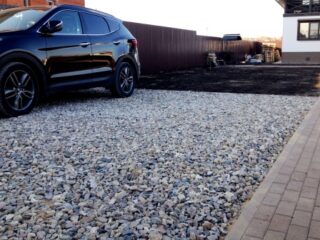
There are no special requirements for this kind of parking. It is allowed to place it directly next to the house, not far from the fence - 1 m.The main factor here is convenience:
- The site should be located in relation to the gate, fence and house so that the car has enough space to enter and exit the yard.
- Do-it-yourself parking sizes depend on the size and number of cars.
- The angle of rotation must be taken into account, otherwise the car will not be able to drive in.
- Do not park your car next to a playground, swimming pool, or artificial reservoir.
- You need to choose a flat area for parking.
Other requirements may arise, for example, distance from the recreation area, distance from the red line.
Calculation of the required coverage
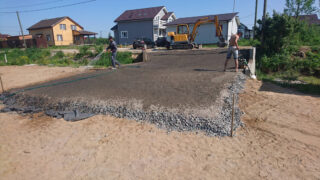
What and how much rubble is needed for parking in the country depends on its design, and the latter determines the size and weight of the car. The main parameter of the site is the thickness of the layer of gravel and sand. On average, a 20 cm layer is sufficient for an urban type car. A heavier car - an off-road vehicle, an executive car, will need a layer of at least 30 cm. For a minibus, an even more solid base will have to be made.
The volume of crushed stone is calculated by multiplying the parking area by the layer thickness. It is recommended to increase the volume by 15% to account for the possibility of soil subsidence.
Characteristics of crushed stone for a car site

Choosing the right backfill material will create a solid site and reduce costs. What crushed stone and what fraction is needed for parking in the country, depends on the size of the car and the type of soil.
The following materials are distinguished:
- Lime is an unsuccessful option for parking. It absorbs water too well and becomes loose. Such a site is quickly overgrown with grass and weeds.
- River gravel - does not crumble, does not stick together, does not lose density. However, such material is relatively expensive.
- Secondary crushed stone - brick and concrete battle. Somewhat heterogeneous, but compacted well. Attracted by the low price and availability.
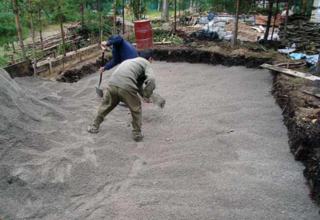
When backfilling, it is recommended to combine material of different fractions. The bottom layer is formed of stone up to 60 mm in diameter. For the top, a small stone is used - with a diameter of 10–20 mm. A shallow embankment fills in voids and cracks and levels the site, while a larger one holds the load.
Crushed stone technical parameters:
- Degree of purification - crushed stone cushion removes water. For parking, choose a stone that contains as little dust as possible.
- Abrasion - too fragile material quickly collapses under the pressure of the wheels and ruts appear on the site.
- Frost resistance - the most resistant gravel crushed stone, but in the southern regions, secondary is also suitable.
In addition to rubble, sand will be required for the site. It is allowed to take a larger ravine.
Preparatory work for the construction of the site
The preparatory stage includes the layout and layout of the site. In this case, you need to keep in mind:
- The plot must be flat. If this condition cannot be met, the foundation is planned taking into account the difference in height.
- The site should have a slight slope so that rainwater can drain off.
- If the groundwater level is high, a drainage system is installed.
- If the car stays in the parking lot overnight, you must immediately find a spot for a flashlight.
The markup is done in the most primitive way. Pegs are placed in the corners of the future parking lot and a rope is pulled.
The site can be equipped with a canopy. It is better to plan such works right away.
Stages of arranging a parking lot from rubble
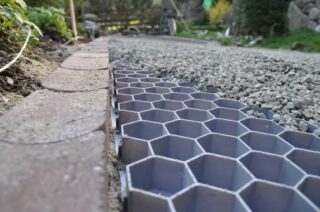
Step-by-step instructions for arranging a parking lot for a personal car in a crushed stone country house include the following steps:
- The top fertile soil is removed from the marked area - 30 cm. Weed roots are thoroughly destroyed. If necessary, you can treat the soil with appropriate compounds to prevent the growth of weeds.
- The bottom of the trench is leveled and tamped with a vibrating plate or roller. This operation should not be neglected: the denser the bottom of the trench, the more stable the foundation will be.
- A layer of sand 10-15 cm thick is placed on the bottom, moistened with water and compacted.
- If necessary, a wooden curb is laid along the perimeter of the trench so that the site does not change over time. It's not obligatory.
- Cover the sand with geotextiles.
- They fill up the parking lot with rubble. First, a larger fraction is laid, on top - a small one, so that it fills the space between large stones. The thickness of the crushed stone layer is 15–20 cm, depending on the weight of the vehicle.
If you intend to wash the car in the parking lot, the site is equipped with a drainage system made of plastic profiled pipes.
Recommendations for arranging a parking space
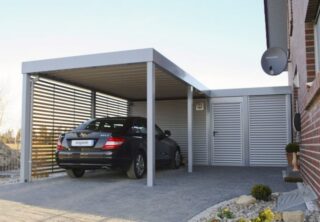
When building a parking space, it is worth considering the following tips:
- The most successful place will be an area where there are already any obstacles for wind and side rain: the wall of a shed or building, a tall dense bush.
- If there is no dog at the dacha and video surveillance is not installed, it is better to park under the windows: there is less chance that the car will be dared to open.
- Elevated areas are preferred as they provide a better view. If the site is in a low place, it will have to be raised.
- After filling the crushed stone, it is recommended to seal it by joining: the car will not slip and get stuck.
A place for a car in the country instead of a garage is a practical and profitable solution. If the house does not live year-round, its cost is much lower than that of a garage box.








